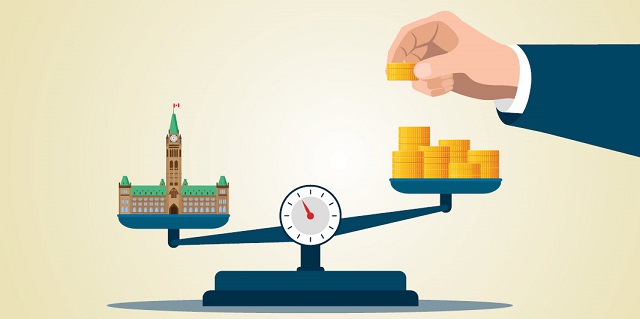Business
Spending restraint: Roadmap to a balanced budget

From the Fraser Institute
A Case for Spending Restraint: How the Federal Government Can Balance the Budget
By Grady Munro and Jake Fuss
Since 2015, there has been a deterioration in the federal government’s fiscal situation. Annual
nominal program spending has increased an estimated $193.6 billion since 2014/15; adjusted for
inflation and population growth this represents an extra $2,330 per person. Prior to the COVID
pandemic, spending increased faster than population, inflation, and other relevant economic
indicators. These spending increases have resulted in a string of large budgetary deficits that have
contributed to an estimated $941.9 billion increase in gross federal debt from 2014/15 to 2023/24.
This accumulation of debt, along with recent hikes in interest rates, has raised the cost of interest
on the federal debt to one of the largest budget expense items.
Moving forward, the federal government plans to slow nominal spending growth, which will keep inflation-adjusted, per-person spending relatively constant to 2026/27. Despite this, the federal government will continue running budget deficits and accumulating debt. It is also uncertain whether the federal government’s current estimates are truly reliable as the estimates do not incorporate expected spending on pharmacare or the level of defence spending to meet Canada’s NATO commitment. Moreover, the federal government’s track record of exceeding previous spending commitments calls into question the reliability of the current spending targets. Therefore, it is clear the federal government is not implementing the level of spending restraint necessary to reverse course towards a stable fiscal situation.
An approach to federal finances that continues to run budget deficits and accumulate debt is economically harmful to both current and future generations of Canadians. Research shows that significant increases in debt-financed spending harm economic growth by reducing capital accumulation and labour productivity.
Furthermore, accumulating debt today increases the tax burden on future generations of Canadians, as they will be responsible for paying off this debt. Despite these effects, the federal government plans to continue running deficits and accumulating debt for the foreseeable future.
This need not be the case. The federal government can undertake decisive spending reform starting in 2024— similar to the reform by the Chrétien government in the 1990s—that balances the budget within a year or two. The federal government could balance the budget in 2026/27 by limiting annual growth in nominal program spending to 0.3% for two years. This would result in a 5.9% reduction in real per-person spending. Alternatively, the budget could be balanced in 2025/26 if the federal government reduces spending 4.3% for one year; the next year, 2026/27, would see a budgetary surplus. In this scenario, inflation-adjusted per-person spending would decline by 7.5%. Key trade-offs between the two approaches include the extent of the spending reform and the speed of the return to balanced budgets. Balancing the budget in one year, as opposed to two years, would
result in $30.0 billion less debt accumulated by 2026/27.
Though it is beyond the scope of this study to discuss how such spending reforms should be implemented, there are three areas that might be considered for reform. Business subsidies are a significant expense, yet research suggests they have little if any economic benefit, and may actually harm economic growth when governments pick winners and losers in a free market. Reviewing business subsidies might provide opportunities to find savings. Aligning government-sector wages
with those in the private sector would also provide savings, as government workers in Canada currently enjoy an 8.5% wage premium (on average) relative to comparable private-sector workers. Finally, studies show that government fiscal waste can be significant. From 1988 to 2013, more than 600 government failures cost the federal government between $158.3 billion and $197.1 billion. Moreover, more than 25% of all federal COVID spending was wasteful. Addressing inefficiencies within government might also reveal savings.

- Canada has seen a deterioration in the federal government’s fiscal situation since 2015. A distinct lack of spending restraint has resulted in a string of large budget deficits, which have contributed to rising government debt and debt interest costs.
- Despite current fiscal plans promising more of the same, the federal government could implement decisive spending reform starting in 2024/25, similar to reforms implemented in the 1990s, and balance the budget within one or two years.
- To balance the budget by 2026/27, the federal government would need to limit growth in annual nominal program spending to 0.3 percent for two years. This would translate to a 5.9 percent reduction in inflation-adjusted, per-person spending.
- Alternatively, the federal government could balance the budget in one year, by 2025/26, by reducing nominal program spending by 4.3 percent. Adjusted for inflation and population, this would be a 7.5 percent decrease. In 2026/27, the federal government could then record a $8.2 billion surplus even while increasing spending from the previous year.
- While this study does not provide an in-depth analysis of where potential savings should be found, research highlights three potential areas that could be targeted for spending reform: corporate welfare, aligning government-sector wages with those in the private sector, or eliminating government fiscal waste.
A Case for Spending Restraint in Canada: How the Federal Government Can Balance the Budget
Authors:
Agriculture
Canada’s supply management system is failing consumers

This article supplied by Troy Media.
The supply management system is cracking. With imports climbing, strict quotas in place and Bill C202 on the table, we’re struggling to feed ourselves
Canada’s supply management system, once seen as a pillar of food security and agricultural self-sufficiency, is failing at its most basic function:
ensuring a reliable domestic supply.
According to the Canadian Association of Regulated Importers, Canada imported more than 66.9 million kilograms of chicken as of June 14, a 54.6 per cent increase from the same period last year. That’s enough to feed 3.4 million Canadians for a full year based on average poultry consumption—roughly 446 million meals. Under a tightly managed quota system, those meals were supposed to be produced domestically. Instead imports now account for more than 12 per cent of this year’s domestic chicken production, revealing a growing dependence on foreign supply.
Supply management is Canada’s system for regulating dairy, poultry and egg production. It uses quotas and fixed prices to match domestic supply with demand while limiting imports, intended to protect farmers from global price swings and ensure stable supply.
To be fair, the avian influenza outbreak has disrupted poultry production and partially explains the shortfall. But even with that disruption, the numbers are staggering. Imports under trade quotas set by the World Trade Organization, the Canada-United States Mexico Agreement and the Comprehensive and Progressive Agreement for Trans-Pacific Partnership are running at or near their allowable monthly share—known as pro-rata
levels—signalling not just opportunity, but urgency. Supplementary import permits, meant to be used only in emergencies, have already surpassed 48 million kilograms, exceeding total annual import volumes in some previous years. This isn’t a seasonal hiccup. It’s a systemic failure.
The system, designed to buffer domestic markets from global volatility, is cracking under internal strain. When emergency imports become routine, we have to ask: what exactly is being managed?
Canada’s most recent regulated chicken production cycle, which ended May 31, saw one of the worst shortfalls in over 50 years. Strict quota limits stopped farmers from producing more to meet demand, leaving consumers with higher grocery bills and more imported food, shaking public confidence in the system.
Some defenders insist this is an isolated event. It’s not. For the second straight week, Canada has hit pro-rata import levels across all chicken categories. Bone-in and processed poultry, once minor players in emergency import programs, are now essential just to keep shelves stocked.
And the dysfunction doesn’t stop at chicken. Egg imports under the shortage allocation program have already topped 14 million dozen, a 104 per cent jump from last year. Not long ago, Canadians were mocking high U.S. egg prices. Now theirs have fallen. Ours haven’t.
All this in a country with $30 billion in quota value, supposedly designed to protect domestic production and reduce reliance on imports. Instead, we’re importing more and paying more.
Rather than addressing these failures, Ottawa is looking to entrench them. Bill C202, now before the Senate, seeks to shield supply management from future trade talks, making reform even harder. So we must ask: is this really what we’re protecting?
Meanwhile, our trading partners are taking full advantage. Chile, for instance, has increased chicken exports to Canada by more than 63 per cent, now accounting for nearly 96 per cent of CPTPP-origin imports. While Canada doubles down on protectionism, others are gaining long-term footholds in our market.
It’s time to face the facts. Supply management no longer guarantees supply. When a system meant to ensure resilience becomes a source of fragility, it’s no longer an asset—it’s an economic liability.
Dr. Sylvain Charlebois is a Canadian professor and researcher in food distribution and policy. He is senior director of the Agri-Food Analytics Lab at Dalhousie University and co-host of The Food Professor Podcast. He is frequently cited in the media for his insights on food prices, agricultural trends, and the global food supply chain.
Troy Media empowers Canadian community news outlets by providing independent, insightful analysis and commentary. Our mission is to support local media in helping Canadians stay informed and engaged by delivering reliable content that strengthens community connections and deepens understanding across the country.
Business
Prairie provinces and Newfoundland and Labrador see largest increases in size of government

From the Fraser Institute
By Jake Fuss and Grady Munro
A recent study found that Canada has experienced one of the largest increases in the size of government of any advanced country over the last decade. But within Canada, which provinces have led the way?
The size of government refers to the extent to which resources within the economy are controlled and directed by the government, and has important implications for economic growth, living standards, and economic freedom—the degree to which people are allowed to make their own economic choices.
Too much of anything can be harmful, and this is certainly true regarding the size of government. When government grows too large it begins to take on roles and resources that are better left to the private sector. For example, rather than focusing on core functions like maintaining the rule of law or national defence, a government that has grown too large might begin subsidizing certain businesses and industries over others (i.e. corporate welfare) in order to pick winners and losers in the market. As a result, economic growth slows and living standards are lower than they otherwise would be.
One way to measure the size of government is by calculating total general government spending as a share of the economy (GDP). General government spending refers to spending by governments at all levels (federal, provincial, and municipal), and by measuring this as a share of gross domestic product (GDP) we can compare across jurisdictions of different sizes.
A recent study compared the size of government in Canada as a whole with that of 39 other advanced economies worldwide, and found that Canada experienced the second-largest increase in the size of government (as a share of the economy) from 2014 to 2024. In other words, since 2014, governments in Canada have expanded their role within the economy faster than governments in virtually every other advanced country worldwide—including all other countries within the Group of Seven (France, Germany, Italy, Japan, the United Kingdom, and the United States). Moreover, the study showed that Canada as a whole has exceeded the optimal size of government (estimated to fall between 24 and 32 per cent of GDP) at which a country can maximize their economic growth. Beyond that point, growth slows and is lower than it otherwise would be.
However, Canada is a decentralized country and provinces vary as to the extent to which governments direct overall economic activity. Using data from Statistics Canada, the following charts illustrate which provinces in Canada have the largest size of government and which have seen the largest increases since 2014.

The chart above shows total general government spending as a share of GDP for all ten provinces in 2023 (the latest year of available provincial data). The size of government in the provinces varies considerably, ranging from a high of 61.4 per cent in Nova Scotia to a low of 30.0 per cent in Alberta. There are geographical differences, as three Atlantic provinces (Nova Scotia, Prince Edward Island, and New Brunswick) have the largest governments while the three western-most provinces (Alberta, Saskatchewan, and British Columbia) have the smallest governments. However, as of 2023, all provinces except Alberta exceeded the optimal size of government—which again, is between 24 and 32 per cent of the economy.

To show which provinces have experienced the greatest increase in the size of government in recent years, the second chart shows the percentage point increase in total general government spending as a share of GDP from 2014 to 2023. It should be noted that this is measuring the expansion of the federal government’s role in the economy—which has been substantial nationwide—as well as growth in the respective provincial and municipal governments.
The increases in the size of government since 2014 are largest in four provinces: Newfoundland and Labrador (10.82 percentage points), Alberta (7.94 percentage points), Saskatchewan (7.31 percentage points), and Manitoba (7.17 percentage points). These are all dramatic increases—for perspective, in the study referenced above, Estonia’s 6.66 percentage point increase in its size of government was the largest out of 40 advanced countries.
The remaining six provinces experienced far lower increases in the size of government, ranging from a 2.74 percentage point increase in B.C. to a 0.44 percentage point increase in Quebec. However, since 2014, every province in Canada has seen government expand its role within the economy.
Over the last decade, Canada has experienced a substantial increase in the size of total government. Within the country, Newfoundland and Labrador and the three Prairie provinces have led the way in growing their respective governments.
-

 Opinion1 day ago
Opinion1 day agoBlind to the Left: Canada’s Counter-Extremism Failure Leaves Neo-Marxist and Islamist Threats Unchecked
-

 Business1 day ago
Business1 day agoWhy it’s time to repeal the oil tanker ban on B.C.’s north coast
-

 Alberta1 day ago
Alberta1 day agoAlberta Provincial Police – New chief of Independent Agency Police Service
-

 Alberta1 day ago
Alberta1 day agoPierre Poilievre – Per Capita, Hardisty, Alberta Is the Most Important Little Town In Canada
-

 COVID-191 day ago
COVID-191 day agoTop COVID doctor given one of Canada’s highest honors
-

 Business1 day ago
Business1 day agoLatest shakedown attempt by Canada Post underscores need for privatization
-

 MxM News1 day ago
MxM News1 day agoUPenn strips Lia Thomas of women’s swimming titles after Title IX investigation
-

 Agriculture7 hours ago
Agriculture7 hours agoCanada’s supply management system is failing consumers




